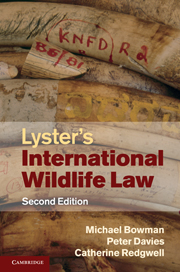Book contents
- Frontmatter
- Contents
- Foreword
- Preface
- List of abbreviations
- PART I Foundations of international wildlife law
- PART II Species regulation
- PART III Regional wildlife regulation
- 8 The Convention on Nature Protection and Wildlife Preservation in the Western Hemisphere
- 9 The African Convention on the Conservation of Nature and Natural Resources
- 10 The Convention on the Conservation of European Wildlife and Natural Habitats
- 11 Polar regions
- 12 Other regional and subregional arrangements
- PART IV Global wildlife regulation
- PART V Biological diversity: a new perspective on wildlife regulation
- PART VI Cross-sectoral issues in wildlife regulation
- PART VII Conclusion
- Index
- References
9 - The African Convention on the Conservation of Nature and Natural Resources
Published online by Cambridge University Press: 05 July 2011
- Frontmatter
- Contents
- Foreword
- Preface
- List of abbreviations
- PART I Foundations of international wildlife law
- PART II Species regulation
- PART III Regional wildlife regulation
- 8 The Convention on Nature Protection and Wildlife Preservation in the Western Hemisphere
- 9 The African Convention on the Conservation of Nature and Natural Resources
- 10 The Convention on the Conservation of European Wildlife and Natural Habitats
- 11 Polar regions
- 12 Other regional and subregional arrangements
- PART IV Global wildlife regulation
- PART V Biological diversity: a new perspective on wildlife regulation
- PART VI Cross-sectoral issues in wildlife regulation
- PART VII Conclusion
- Index
- References
Summary
Background
The first international agreement to conserve African wildlife was signed in London on 19 May 1900 and was called the Convention for the Preservation of Wild Animals, Birds and Fish in Africa. It was signed by the colonial powers then governing much of Africa – France, Germany, Great Britain, Italy, Portugal and Spain – and its objective was ‘to prevent the uncontrolled massacre and to ensure the conservation of diverse wild animal species in their African possessions which are useful to man or inoffensive’. The teeming herds of African wild animals were already starting to diminish, and the primary goal of the Convention was to preserve a good supply of game for trophy hunters, ivory traders and skin dealers.
The 1900 Convention prohibited the killing of all specimens of species listed in Schedule 1 of the Convention and ‘any other animals whose protection, owing to their usefulness or to their rarity and threatened extermination, may be considered necessary by each Local Government’. Schedule 1 was divided into Series A (‘useful animals’) and Series B (‘animals that are rare and in danger of disappearance’). Series A contained the secretary bird and all vultures, owls and oxpeckers. Series B consisted of ‘giraffe, gorillas, chimpanzee, mountain zebra, wild asses, white tailed gnu, elands and pygmy hippopotamus’. The Convention also prohibited the killing of non-adults and females ‘when accompanied by their young’ of ‘elephant, rhinoceros, hippopotamus, zebra other than mountain zebra, buffalo, antelope and gazelles, ibex and mouse deer’.
- Type
- Chapter
- Information
- Lyster's International Wildlife Law , pp. 262 - 296Publisher: Cambridge University PressPrint publication year: 2010



